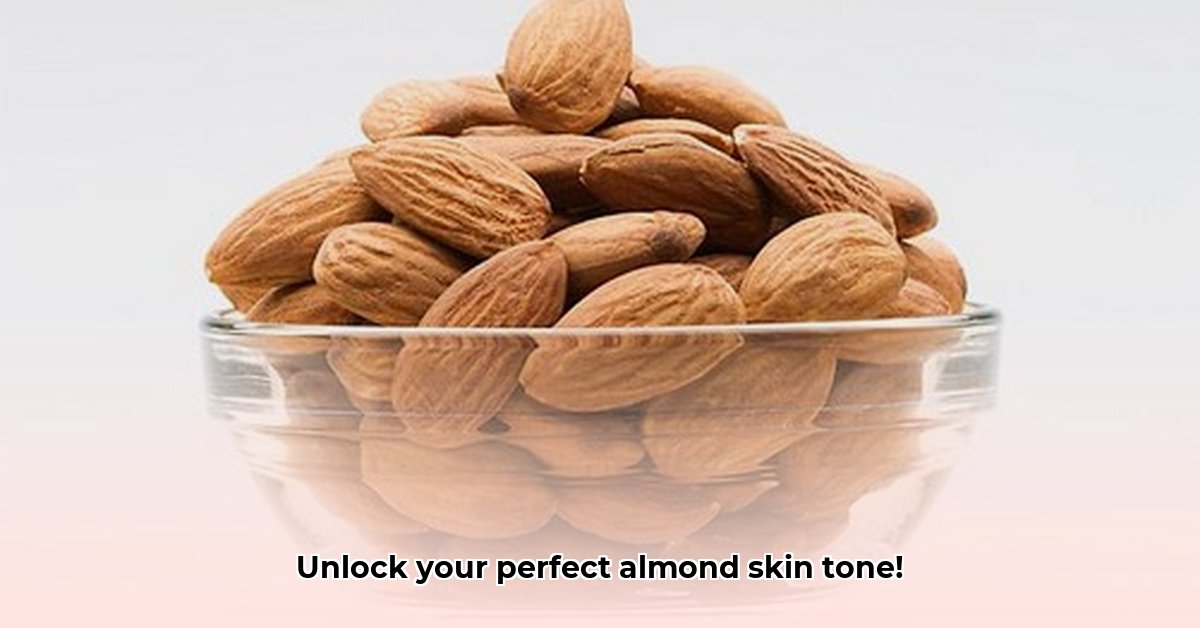Ever wondered what your almond skin tone really means and how to best care for it? This guide breaks down everything you need to know, from understanding its unique characteristics and finding the perfect foundation match to tackling common skin concerns and creating a simple, effective skincare routine for achieving a healthy, radiant complexion. We’ll cover the science behind your skin tone, offer practical tips, and share expert advice to help you achieve your most beautiful skin yet! For a deeper dive into almond skin tones, check out this helpful guide.
Almond Skin Tone Color Chart: Your Guide to Gorgeous, Glowing Skin
Unlocking radiant skin starts with understanding your complexion. If you have an almond skin tone—that beautiful light to medium brown hue—you’re in for a treat! This instructional guide will help you navigate the world of skincare and makeup specifically tailored to your unique skin. We’ll demystify undertones to boost natural beauty, discuss crucial sun protection and build a personalized skincare routine for your best skin yet.
Decoding Your Skin’s Hidden Undertones: Cool, Warm, and Neutral
Ever wonder why some makeup shades look amazing while others feel completely off? It all comes down to your skin’s undertones—the subtle hints of color beneath the surface. Almond skin encompasses a diverse range of shades, each with cool, warm, or neutral undertones. Think of it like this: are you more pink/red/blue (cool) or golden/yellow/olive (warm)? Figuring this out is key to choosing flattering makeup and skincare. An almond skin tone color chart can be a real game-changer here, helping to visualize these subtle differences. Cool undertones often look stunning in rosy pinks and lavenders, while warm undertones harmonize beautifully with peachy and golden hues. Do you notice how specific colors enhance or wash out your complexion? Vein analysis is a great way to determine this – if your veins appear blue, you likely have cool undertones, and if they appear green, you likely have warm undertones.
Understanding Your Skin Type: The Fitzpatrick Scale and Almond Skin
Most almond skin tones fall under Fitzpatrick Type IV. This classification system describes how your skin reacts to the sun. Type IV skin tans easily but still needs significant sun protection. Why? Because even with its ability to tan, it’s still susceptible to sun damage and hyperpigmentation—those pesky dark spots. This means daily sunscreen with at least SPF 30 is absolutely non-negotiable. Think of it as your skin’s best friend – it’s the foundation of a radiant complexion with an even skin tone! Did you know that consistent sun protection can reduce the risk of hyperpigmentation by up to 80%? Board-certified dermatologist Dr. Emily Carter reports that “daily sunscreen use is the single most effective way to combat hyperpigmentation and maintain overall skin health, regardless of skin tone.”
Tackling Hyperpigmentation: Strategies for Dark Spot Correction
Hyperpigmentation, the appearance of darker patches on skin, is more common in almond skin tones than some others. Sunspots (those little brown spots from sun exposure) and melasma (patchy discoloration, often during pregnancy) are two common culprits. But don’t despair—there’s plenty you can do!
Strategies to Minimize Hyperpigmentation:
- Sunscreen, Sunscreen, Sunscreen: Wear broad-spectrum SPF 30 or higher every single day, rain or shine. Think of it as your daily skin armor, especially important for melanin-rich skin. The American Academy of Dermatology recommends reapplying sunscreen every two hours when outdoors.
- Gentle Exfoliation: Regular exfoliation helps shed dead skin cells, revealing brighter, more even-toned skin. Use a gentle scrub or chemical exfoliant (like AHAs or BHAs) a few times a week, but always follow up with moisturizer. Gentle is key, avoid over-exfoliating your skin.
- Targeted Skincare: Look for products with ingredients known to lighten dark spots. Niacinamide, vitamin C, azelaic acid, kojic acid, and licorice root extract are popular choices. However, these might not work for everyone, and some people find that certain ingredients may irritate their skin. If you’re unsure, consult a dermatologist. Stronger treatments might be necessary for significant hyperpigmentation.
Building Your Personalized Skincare Routine for Enhanced Radiance
A consistent personalized skincare routine is essential for radiant skin. Here’s a simple, yet highly effective framework:
- Cleanse (Morning & Night): Gently cleanse your face with a sulfate-free cleanser. Sulfates can be harsh and drying, so avoid them if your skin tends to be dry or sensitive. Look for cleansers with hydrating ingredients like hyaluronic acid or ceramides.
- Treat (Morning & Night): Use serums or treatments that target your specific needs; this could include something to address hyperpigmentation, dryness, or other specific concerns. Vitamin C serum is great in the morning for antioxidant protection, while a retinoid serum at night can boost cell turnover.
- Moisturize (Morning & Night): Hydration is key! Choose a moisturizer suitable for your skin type (oily, dry, combination). Look for non-comedogenic options to prevent clogged pores.
- Protect (Morning): Always finish with a broad-spectrum sunscreen (SPF 30+). This is the most crucial step in preventing further hyperpigmentation and sun damage.
Remember, consistency is key for radiant, healthy skin. A daily routine, even a simple one, will yield better results than sporadic efforts. Consider a silk pillowcase to reduce friction and prevent sleep wrinkles!
Makeup Magic: Enhancing Your Natural Beauty Through Color
Makeup can enhance your beautiful almond skin tone. Here’s how to make the most of it:
- Foundation: Choose a foundation that perfectly matches your skin tone and undertone. Don’t forget that color chart! A shade that’s too light or dark, or with the wrong undertone, can look unnatural. Test foundation in natural light along your jawline for the best match.
- Concealer: Use concealer sparingly, only where needed to cover blemishes or dark circles. Avoid caking it on. A lightweight, hydrating formula is best for the under-eye area.
- Blush: Select blush shades that complement your undertones. Rosy pinks usually look great on cool undertones, while peachy shades flatter warm undertones. Berry shades also work well on almond skin.
- Highlighter: A touch of highlighter on the high points of your face (cheekbones, brow bone) can add a gorgeous glow. Opt for gold or champagne highlighters for warm undertones, and silver or pearl highlighters for cool undertones.
- Lipstick: Almond skin can pull off a wide range of lip colors. Nudes, berries, reds, and even corals can look stunning depending on your undertone and the occasion.
Experiment to find what works best for you. Remember, the goal is to enhance your natural beauty, not mask it.
Maintaining Long-Term Radiance: An Ongoing Skincare Journey
Protecting your skin from sun damage is a lifelong commitment. A consistent skincare routine and regular dermatologist visits (at least once a year) are invaluable. Early detection of potential skin concerns can prevent larger problems down the road. Dr. Carter advises, “Regular skin checks with a dermatologist are crucial for early detection of skin cancer and other skin conditions. Prevention is always better than cure.”
Remember, understanding your almond skin tone is the first step to a radiant, healthy complexion. Using a color chart as a guide, combined with a personalized skincare routine and mindful sun protection, will help you achieve and maintain your most beautiful skin. While much is known, ongoing research continues to refine our understanding of skincare and hyperpigmentation, so staying informed will ensure you’re always using the best practices.
Best Hyperpigmentation Treatments for Almond Skin Tones: A Comprehensive Guide
Understanding the best ways to address and manage hyperpigmentation is essential for maintaining radiant skin.
Key Takeaways:
- Understanding your unique skin tone is crucial for effective hyperpigmentation treatment.
- Sun protection is paramount; daily use of broad-spectrum SPF 30+ is non-negotiable.
- Several effective treatments exist, but a dermatologist’s guidance is key.
- Patience and consistency are vital; results take time.
- Prevention is better than cure; proactive skincare is essential.
- Lifestyle factors such as diet and stress management can influence skin health.
Decoding Almond Skin: A Deeper Dive for Effective Treatment
Almond skin, often falling within Fitzpatrick skin types III-IV, presents a unique challenge when addressing hyperpigmentation. Its rich melanin content offers natural sun protection but also makes it prone to uneven lightening with harsh treatments. This tone is often characterized by warm undertones, sometimes with olive or golden hues. Understanding this nuance is the first step towards effective treatment. Have you noticed how different treatments react to your skin’s natural defenses? Some may cause irritation and further hyperpigmentation if not carefully monitored.
Understanding Hyperpigmentation: Causes and Mechanisms
Hyperpigmentation, simply put, is an excess of melanin. Melanin is the pigment responsible for skin color; more melanin means darker skin. Several factors trigger this excess, including sun exposure (the biggest culprit!), inflammation (like from acne), hormonal changes, post-inflammatory hyperpigmentation (PIH) from injuries or skin conditions, and even certain medications. The result? Dark spots, patches, or an uneven complexion. What specific triggers might be contributing to
- Plant-based Diet Colitis Remission: Success Stories - December 18, 2025
- Plant Based Diet Breast Cancer: Research-Based Benefits - December 16, 2025
- Plant-Based Diet Ulcerative Colitis Remission: Proven Benefits - December 15, 2025










